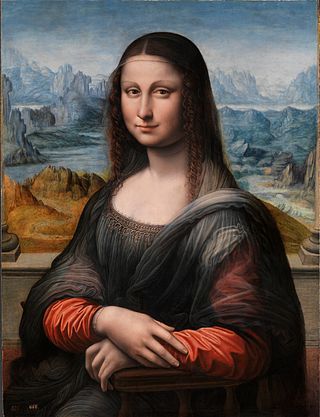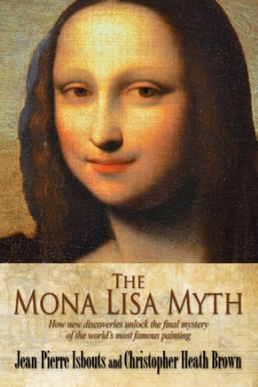
The Mona Lisa is a half-length portrait painting by Italian artist Leonardo da Vinci. Considered an archetypal masterpiece of the Italian Renaissance, it has been described as "the best known, the most visited, the most written about, the most sung about, [and] the most parodied work of art in the world". The painting's novel qualities include the subject's enigmatic expression, monumentality of the composition, the subtle modelling of forms, and the atmospheric illusionism.

Art theft, sometimes called artnapping, is the stealing of paintings, sculptures, or other forms of visual art from galleries, museums or other public and private locations. Stolen art is often resold or used by criminals as collateral to secure loans. Only a small percentage of stolen art is recovered—an estimated 10%. Many nations operate police squads to investigate art theft and illegal trade in stolen art and antiquities.

Art forgery is the creation and sale of works of art which are intentionally falsely credited to other, usually more famous artists. Art forgery can be extremely lucrative, but modern dating and analysis techniques have made the identification of forged artwork much simpler.

Vincenzo Peruggia was an Italian museum worker, artist and thief, most famous for stealing the Mona Lisa from the Louvre Museum in Paris on 21 August 1911.

La Belle Ferronnière is a portrait painting of a lady, by Leonardo da Vinci, in the Louvre. It is also known as Portrait of an Unknown Woman. The painting's title, applied as early as the seventeenth century, identifying the sitter as the wife or daughter of an ironmonger, was said to be discreetly alluding to a reputed mistress of Francis I of France, married to a certain Le Ferron. Later she was tentatively identified as Lucretia Crivelli, a married lady-in-waiting to Duchess Beatrice of Milan, who became another of the Duke's mistresses.
Events from the year 1932 in art.

Leonardo da Vinci was an Italian Renaissance painter and polymath who achieved legendary fame and iconic status within his own lifetime. His renown primarily rests upon his brilliant achievements as a painter, the Mona Lisa and The Last Supper, being two of the most famous artworks ever created, but also upon his diverse skills as a scientist and inventor. He became so highly valued during his lifetime that the King of France bore him home like a trophy of war, supported him in his old age and, according to legend, cradled his head as he died.
Eduardo de Valfierno, who posed as a marqués (marquis), was supposedly an Argentine con man who allegedly masterminded the theft of the Mona Lisa in 1911. There are serious doubts as to whether or not he existed.

The Isleworth Mona Lisa is an early 16th-century oil on canvas painting depicting the same subject as Leonardo da Vinci's Mona Lisa, though with the subject depicted as being a younger age. The painting is thought to have been brought from Italy to England in the 1780s, and came into public view in 1913 when the English connoisseur Hugh Blaker acquired it from a manor house in Somerset, where it was thought to have been hanging for over a century. The painting would eventually adopt its unofficial name of Isleworth Mona Lisa from Blaker's studio being in Isleworth, West London. Since the 1910s, experts in various fields, as well as the collectors who have acquired ownership of the painting, have asserted that the major elements of the painting are the work of Leonardo himself, as an earlier version of the Mona Lisa.
Anthony Gene Tetro, known as Tony Tetro, is an art forger known for his perfectionism in copies of artwork produced in the 1970s and 1980s. Tetro never received formal art lessons, but learned from books, by painting and experimentation. Over three decades, Tetro forged works by Rembrandt, Joan Miró, Marc Chagall, Salvador Dalí and Norman Rockwell and others. Tetro's paintings and lithographs, known for their perfectionism, were sold by art dealers and auction houses as legitimate works and hang in museums, galleries around the world. He was caught after Hiro Yamagata found a forgery of his own work for sale in a gallery.

The Theft of the Mona Lisa is a 1931 German drama film directed by Géza von Bolváry and starring Trude von Molo, Willi Forst, and Gustaf Gründgens. It is based on a true story. It was shot at the Tempelhof Studios in Berlin. The film's sets were designed by the art directors Andrej Andrejew and Robert A. Dietrich.

The 16th-century portrait Mona Lisa, or La Gioconda, painted in oil on a poplar panel by Leonardo da Vinci, has been the subject of a considerable deal of speculation.

Gian Giacomo Caprotti da Oreno, better known as Salaì was an Italian artist and pupil of Leonardo da Vinci from 1490 to 1518. Salaì entered Leonardo's household at the age of ten. He created paintings under the name of Andrea Salaì. He was described as one of Leonardo's students and lifelong companion and servant and was the model for Leonardo's St. John the Baptist, Bacchus and Angelo incarnato.
The following outline is provided as an overview and topical guide to forgery:

Leonardo da Vinci's Mona Lisa is one of the most recognizable and famous works of art in the world, and also one of the most replicated and reinterpreted. Mona Lisa studio versions, copies or replicas were already being painted during Leonardo's lifetime by his own students and contemporaries. Some are claimed to be the work of Leonardo himself, and remain disputed by scholars. Prominent 20th-century artists such as Marcel Duchamp and Salvador Dalí have also produced derivative works, manipulating Mona Lisa's image to suit their own aesthetic. Replicating Renaissance masterpieces continues to be a way for aspiring artists to perfect their painting techniques and prove their skills.
Here below is a chronology of fictional and semi-fictional stories that revolve, either wholly or partially, around the famous Mona Lisa, a portrait of Lisa del Giocondo painted by Leonardo da Vinci during the Renaissance in Florence. The years listed on the left refer to the year of release of these works of fiction.

The Prado Mona Lisa is a painting by the workshop of Leonardo da Vinci and depicts the same subject and composition as Leonardo's better known Mona Lisa at the Louvre, Paris. The Prado Mona Lisa has been in the collection of the Museo del Prado in Madrid, Spain since 1819, but was considered for decades a relatively unimportant copy. Following its restoration in 2012, however, the Prado's Mona Lisa has come to be understood as the earliest known studio copy of Leonardo's masterpiece.

Paul George Konody was a Hungarian-born, London-based art critic and historian, who wrote for several London newspapers, as well as writing numerous books and articles on noted artists and collections, with a focus on the Renaissance. A recognized expert on the art of the Renaissance, he was lauded for his evaluation of claims of authenticity for works from that period, correctly debunking Wilhelm von Bode's assertion that a bust of Flora was sculpted by Leonardo da Vinci. During World War I, Konody became interested in the representation of war in the arts, and directed an effort to commemorate Canadian participation in that war.

The two–Mona Lisa theory is a longstanding theory proposed by various historians, art experts, and others that Leonardo da Vinci painted two versions of the Mona Lisa. Several of these experts have further concluded that examination of historical documents indicates that one version was painted several years before the second.

The Mona Lisa Myth is a multimedia project consisting of a 2013 book and a 2014 documentary film, produced in tandem by Renaissance scholar and art historian Jean-Pierre Isbouts, with physician and art collecter Christopher Heath Brown as co-author of the book and as a producer of the documentary, the latter with narration by Morgan Freeman. The book and film each examine the history of the Mona Lisa, and the longstanding theory that the Isleworth Mona Lisa is an earlier version of the same painting, also by Leonardo da Vinci.













